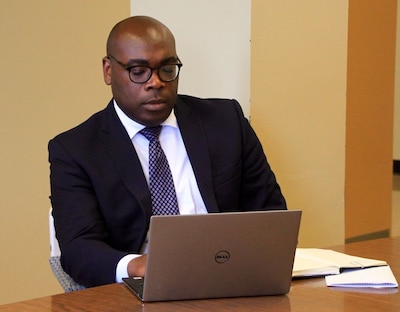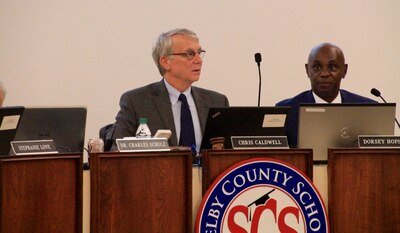The children at Kingsbury Elementary School thought it was funny to have a teacher sitting at a tiny desk, working side-by-side with them.
But Dawn Grayson shadowed several students to help her understand how a new way of allocating money could change the way her Memphis school operates.
Grayson has been part of a team at Kingsbury preparing to switch to a school finance model known as student-based budgeting. It’s a key component of Shelby County Schools’ efforts to ensure state and local money is distributed based on student need.
She was looking at how English language learners, students from low-income families, and students with disabilities, spent their day to help her determine the school’s most urgent needs.
“It’s important that we do step back and say, how do we make this more student-centered?” said Grayson, who has taught English learners there for six years. “We can’t figure out their needs unless we walk their walk.”
But whether or not student-based budgeting will actually help solve school inequities remains to be seen.

Currently, every school receives money based on student enrollment and the number of teachers it takes to teach those students. The final amount given to a school is primarily based on the teachers’ salaries, and the supplies and resources the school needs. The traditional model usually allocates less money to schools with high-needs students because they generally employ less-experienced, lower-paid teachers.
Under the new method that goes into effect for the 2018-19 school year, every school will receive $3,400 per student. Additional money will then be allocated depending on four factors recently determined by Shelby County Schools: first-time readers, students with disabilities, students who score exceptionally high or low on state tests, and students who often move from one home to another.
Altogether, about $377 million, or a little more than a one-third, of the district’s proposed $1.05 billion budget is dedicated to student-based budgeting. How the rest of the money is spent will still be decided by the district’s central office. Charter schools authorized by the district are excluded from the new formula and will still receive money based on student enrollment.
Read more about student-based budgeting and how other districts, such as Nashville, have transitioned to this model.
At the heart of the funding model is allowing principals to make their own decisions about what kinds of jobs are needed and what materials their schools need. The district’s national consultant, Education Resource Strategies, has trained teams at six Memphis schools for the past two years: Brownsville Road Elementary, Craigmont Middle, Craigmont High, Kingsbury Elementary, Kingsbury Middle, and Kingsbury High.

“We see this as empowering principals to make the changes that they think they need to make to promote bottom-up innovation,” said Lin Johnson, who has been the district’s chief finance officer since 2015.
During his three years as principal of Kingsbury Elementary, Wynn Earle didn’t talk much about budgeting because it was never in his control.
“I could want all these positions but I would not have the financial resources to acquire those people,” he said.
With an infusion of about $164,000 under the new model, Earle hired two education assistants and another full-time physical education teacher so that other teachers could have 40 more minutes of planning time every day. Some of the money will also go toward substitutes so that teachers can have more time for training during the school day.
He has hired another bilingual mentor to lead monthly parent meetings with Hispanic families, who make up two-thirds of the student population. Thanks to the new dollars, those meetings will have dinner, and kits to teach parents how to read to their children.
Planning how to spend the money, he said, gave him the opportunity to work more closely with teachers, parents, and even other schools his students will attend, to identify the school’s most urgent needs.
“It made us evaluate ourselves from the inside out,” he said.
Johnson said the public will be able to see how much each school will get before the new fiscal year starts July 1, but as of early August, the district hadn’t released individual school budgets yet. Some schools may see a dip in funding because of the formula or because of an anticipated drop in enrollment. In the first year, a school won’t get more than a 6 percent boost or a 2.5 percent cut, Johnson said, so there won’t be drastic changes in the beginning.
The district will start with principals who have been at their schools at least two years, have a high score on their annual performance evaluation, and whose schools rank three or higher on the district’s five-point report card. Principals will submit applications with a plan on how they will use the money. And over time, the district hopes up to half the budget will be distributed this way. Leaders want to see this year’s results before deciding when to transition every school.

Chris Caldwell, who chairs the school board’s budget committee, said student-based budgeting needs to be assessed regularly to make sure it’s producing its intended purpose: equity in funding.
Student-based budgeting “can be helpful to identify inequities, but it doesn’t guarantee responses that will eliminate” them, he said, adding the state’s “outdated and inadequate” school staffing formula already puts Tennessee’s largest district at a disadvantage.
Here’s a breakdown of how much money follows students based on the four characteristics prioritized by Shelby County Schools:
Grade level. This is the most common characteristic cited by districts across the nation who use this model. Shelby County Schools will add $1,020 for each student in kindergarten through second grade, and $680 for third- through fifth-graders. That’s a high weight compared to other districts, said Marguerite Roza, a Georgetown University professor who studies school finance.
Johnson said the district put a high weight on younger students because the district is struggling to boost its reading levels. During the 2016-17 school year, just 21 percent of students in third grade were considered by the state to be reading on grade level. That’s far below the district’s goal of 90 percent by 2025.
Students with disabilities. Some costs for students who are disabled won’t be factored into the base amount allotted per student because the district wants to control how federal money and other grants for those students are spent. But the district plans to add $825 for each student with disabilities to contribute more to a school’s administrative and service costs.
Mobility. Instead of using a school’s poverty rate to determine higher need, district leaders want to measure how often students move from school to school, which they say is closely connected to poverty. Each student would garner $340 more for the school. A school’s mobility rate is the number of students who transfer there after the 20th day of school divided by the number of students who attend that year.
Student performance. Achievement on state tests is “one of the most important indicators of student need at a school” according to the district’s proposed budget. Shelby County Schools is hoping to target students transitioning to middle and high school by looking at state test score data for rising sixth- and ninth-graders. Schools will receive $340 for each student who scored below grade level and for each student who scored higher than their grade level on 2016-17 state tests. For elementary schools, that calculation will be based on fourth-graders.
Typically, low-performing students are considered to have the most need in student-based budgeting models that prioritize test scores. But Johnson said the district’s highest achievers also need more supports, such as more advanced courses and ACT preparation, to keep them engaged.
“It’s not just focusing on struggling students,” he said. “There are high-achievers who need to pushed.”
Roza, the Georgetown professor who specializes in this model, said her team does not recommend giving a school more money for students who already are ahead.
“We worry about that because of its equity implications,” she said. “Schools with high performers means that there’s fewer dollars for middle performing schools.”
Grayson, the Kingsbury Elementary teacher, interviewed many of the students she shadowed. She found that students – as well as herself – had little understanding of how money was allocated or spent. She said the new budgeting method gives everyone more opportunity to understand what goes on behind the scenes.
“We hope that it’s a step in the right direction to help students who need it most,” she said.

